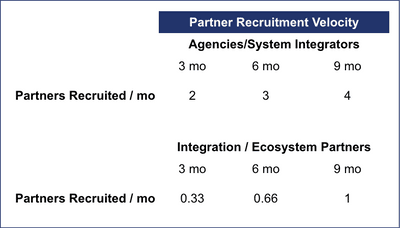How to Conduct Partner Program Financial Forecasting


Financial forecasting for your partner program is an important exercise to undergo both when you’re getting initial approval to invest in partnerships and annually to track the impact of your partner program. Depending on the maturity of your partner program, there are a few different ways you may conduct financial forecasting, and your inputs will vary significantly depending on how enabled your team is.
We’re lucky enough to have had Brian Jambor join us for a Partner Program Financial Forecasting panel. Brian Jambor has managed partnerships at four growing SaaS companies, most recently at Nacelle. Today, we’ll dig into the top takeaways from Brian’s presentation that you can use when financial forecasting for your partner program.
Determining Partner Program Objectives
It’s important to understand what the leadership team expects of the partner program. Determining the program objective can be challenging when the executive you report to (such as the CRO or Head of Marketing) has a different objective for the partner program than the leadership team.
It’s important to meet with your organization’s CEO to determine what the main goal is for the partnership program. If you’re considering joining an organization, this is an essential question to ask everyone you speak with during the interview process.
Partner program objectives might include:
- Brand exposure
- Market defense
- Talent acquisition
- Access to capital
- Revenue
- Market share
- Customer adoption
- Revenue retention
Typically, however, revenue is the most important objective for partnerships when it comes to the leadership team. Everything else can be considered a leading indicator for revenue — all roads lead to revenue, but there are a lot of other goals that come into play along the way.
Revenue won’t happen right away, and sometimes your program won’t be profitable for the first year. For new partner programs, there should be objectives around figuring your program out ahead of growing revenue.
Suppose your leadership team is dead set on driving revenue as a primary objective or pushes back on how long it will take to get to profitability. In that case, you can present your financial forecast. Together with your leadership team, you can explore the different levers of your financial forecast that you can pull to generate revenue faster or optimize resources invested in your program.
Creating a Partner Program Financial Forecast
It’s a good idea to conduct financial forecasting when you’re first starting your partner program, as well as at the beginning of each fiscal year. Over time, your forecast will vary significantly. After all, many factors limit your revenue early on, then opportunities enabling exponential growth arise later.
Financial Forecasting Inputs
To develop your financial forecast, there are a few inputs you’ll need to include. The first is your partnerships organizational structure.
When you begin a partner program, there’s a good chance one individual is responsible for partner management, operations, marketing, and recruitment. As you grow your program and your impact increases, you can specialize. For example, you may have two Partner Managers, one focused on tech partners and the other on agency partners.
If your company goes global, these positions begin to regionalize. Then, you begin having not just a Partner Manager, but also a Partner Director who leads Partner Managers in each different market. Eventually, you’ll be able to have an entire team of Partner Managers for just one region.
The next input to consider is your partner recruitment velocity. It takes time to develop your ideal partner profile — anywhere from 90-120 days to nail down your Good/Better/Best partners. You should take the first six months and test the waters. Sometimes, you need to have board-level conversations with your executive team to emphasize the value of testing.
You’ll get a lot of Good and Better partners making up your ecosystem, while Best will be harder to find. Meanwhile, the amount of Best partners you bring on directly impacts revenue.
From there, you should consider your partner onboarding velocity. Over time, the velocity of bringing on partners increases exponentially. When your partner manager starts, they won’t recruit as many partners. As you refine your value proposition and learn more about your program, you’ll gain velocity.
Similarly, as you staff up or potentially use a third party, partner recruitment continues to ramp up over time. The number of partners you can recruit over a month changes drastically based on a few factors, including:
- How long your partner managers have been on your team
- The complexity of your onboarding process
- Your team size
The final input to consider is your partner program budget. It’s true that you have to spend money to make money. App marketplace accelerators can be key to growth if you’re building a tech partner program. Similarly, tools like Crossbeam for account mapping or Allbound for partner relationship management can help you accelerate your program’s growth significantly. And, of course, we always recommend including Partnership Leaders as a line item in your partner program budget.
Financial Forecasting Outputs
It could take three, six, even nine months to start seeing revenue from your partner program. As such, you need to be conscious of operational expenses compared to financial output. The executive team might not be worried about an immediate return on investment and instead focus on other impact channels, but this will vary by maturity and leadership team.
Financial forecasting is an activity you can do on your own as a partner leader and keep in your back pocket. Then, when you have a conversation with your leadership team, if there are ever questions about validating the strategy, you can dive into the research you did to get here.
When you present your financial forecast to your leadership team, you can work together to evaluate which levers you want to pull in order to achieve an outcome you’re both happy with.
Explore More Powerful Insights for Advancing Your Partner Program
Now is a great time to conduct a financial forecasting exercise. Evaluate your partnerships organizational structure, partner recruitment velocity, partner onboarding velocity, and program budget to determine your financial forecast. Then, work with your leadership team to decide where you need to adjust in order to achieve your program’s objectives.
Thanks again to Brian Jambor for sharing his insights on partner program financial forecasting. You can connect with Brian on LinkedIn or within the Partnership Leaders Slack community. If you missed Brian’s presentation and want to watch the full fireside chat, you can access it here after submitting the form.
Partnership Leaders connects professionals from modern technology companies looking to advance their careers, expand their partner programs, and grow their organizations. Whether you’re looking to land a new role in partnerships, excel in your existing role, or grow your team, Partnership Leaders has resources for it all. Apply now to network with Brian Jambor and over 700 other partnerships professionals.



